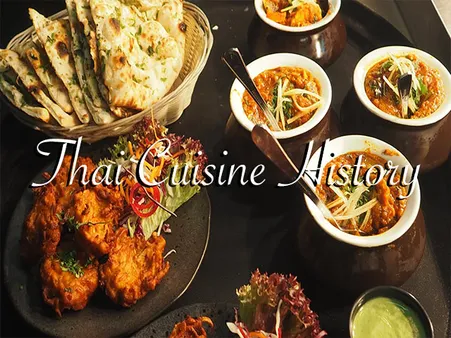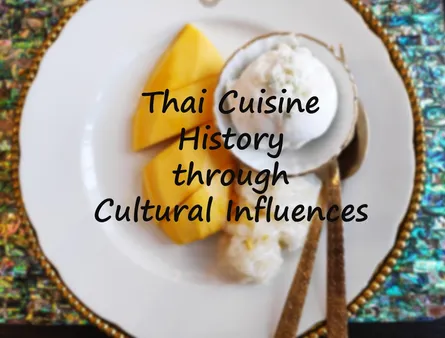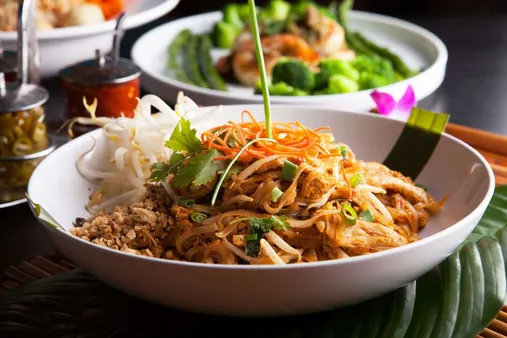Table of Contents
Embark on a culinary adventure through the vibrant tapestry of Thai cuisine on Tauhuichiban. Steeped in a rich history and influenced by diverse cultures, Thai food has blossomed into a symphony of flavors that tantalizes the taste buds. From the delicate artistry of royal dishes to the vibrant street food, each dish tells a story of tradition, heritage, and the unique customs that shape this beloved cuisine. Join us as we delve into The history and culture of Thai cuisine, uncovering the origins, influences, and culinary practices that have made it a global treasure.

The History and Culture of Thai Cuisine: A Culinary Journey Through Time
I. The History of Thai Cuisine
The history of Thai cuisine is a long and fascinating one, dating back to the early days of the Kingdom of Siam. The cuisine has been influenced by a variety of factors, including the country's geography, climate, and cultural interactions with neighboring countries. Thai cuisine is known for its bold flavors, which are achieved through the use of fresh ingredients, herbs, and spices.
One of the most important ingredients in Thai cooking is rice. Rice is a staple food in Thailand, and it is used in a variety of dishes, including stir-fries, curries, and desserts. Other common ingredients in Thai cuisine include noodles, vegetables, meat, and seafood. Herbs and spices are also essential to Thai cooking and play a key role in giving Thai dishes their distinctive flavors. Some of the most common herbs and spices used in Thai cuisine include lemongrass, galangal, kaffir lime leaves, and chili peppers.
Region | Signature Dishes | Key Ingredients |
|---|---|---|
Northern | Khao soi, Sai ua, Nam phrik ong | Sticky rice, pork, chili peppers |
Central | Pad see ew, Tom yum goong, Gaeng massaman | Noodles, shrimp, coconut milk |
Northeastern | Som tum, Larb, Khao piak sen | Green papaya, minced meat, rice noodles |
Southern | Gaeng som, Kua kling, Khanom jeen | Coconut milk, seafood, rice noodles |
Thai cuisine has also been influenced by cultural interactions with neighboring countries. For example, the use of chili peppers in Thai cuisine is thought to have been introduced by the Portuguese in the 16th century. The Chinese have also had a significant influence on Thai cuisine, and many Thai dishes, such as stir-fries and noodles, have their roots in Chinese cooking.
Today, Thai cuisine is enjoyed all over the world. It is known for its delicious flavors, which are a result of the careful blending of fresh ingredients, herbs, and spices. Thai cuisine is also known for its variety, which means that there is something to suit every taste.

The History of Thai Cuisine
II. The Influences on Thai Cuisine
Thai cuisine has evolved over several centuries, influenced by neighboring countries and cultures. The unique flavors and ingredients of Thai food reflect a blend of traditions and culinary practices. Here are some notable influences:
**Chinese influence**: Chinese traders and immigrants introduced ingredients like soy sauce, noodles, and stir-frying techniques to Thai cuisine.**Indian influence**: Thai cuisine shares many spices and flavors with Indian cooking, including chili peppers, turmeric, and cumin.**Southeast Asian influence**: Neighboring countries like Laos, Cambodia, and Myanmar have contributed ingredients and dishes to Thai cuisine, such as sticky rice, coconut milk, and curries.
These influences have resulted in the distinct and diverse flavors of Thai food, which is known for its balance of sweet, sour, salty, and spicy elements. The use of fresh ingredients, herbs, and spices gives Thai cuisine its characteristic aromas and flavors.
**Table: Regional Variations in Thai Cuisine**| Region | Notable dishes | Characteristics ||---|---|---|| Central Thailand | Pad Thai, Tom Yum Goong | Sweet and sour flavors, use of coconut milk || Northern Thailand | Khao Soi, Sai Oua | Spicy and sour flavors, use of sticky rice || Northeastern Thailand | Som Tum, Larb | Spicy and tangy flavors, use of fermented ingredients || Southern Thailand | Gaeng Tai Pla, Kua Kling | Spicy and salty flavors, use of seafood and coconut milk |
In addition to these influences, Thai cuisine has also been shaped by religious and cultural practices. Buddhism, for example, has influenced the vegetarian and vegan options available in Thai food. The monarchy and royal court have also played a role in developing and refining Thai cuisine.

The Influences on Thai Cuisine
III. The Regional Variations of Thai Cuisine
Thai cuisine is known for its bold flavors and diverse dishes, and these characteristics are influenced by the country's geography and history. Thailand is divided into four main regions: the North, Northeast, Central, and South. Each region has its own unique culinary traditions, which have been shaped by the local climate, ingredients, and cultural influences.
The North is known for its mild climate and mountainous terrain. The cuisine of this region is influenced by neighboring Laos and Myanmar, and features dishes such as khao soi, a noodle soup with a rich coconut milk broth, and sai ua, a grilled sausage made with pork and herbs.
Region | Climate | Influences | Signature Dishes |
|---|---|---|---|
North | Mild, mountainous | Laos, Myanmar | Khao soi, sai ua |
Northeast | Hot, dry | Laos, Cambodia | Som tum, larb |
Central | Tropical, humid | China, India | Pad thai, tom yum goong |
South | Tropical, coastal | Malaysia, Indonesia | Gaeng tai pla, khao mok |
The Northeast is the hottest and driest region of Thailand. The cuisine of this region is influenced by neighboring Laos and Cambodia, and features dishes such as som tum, a spicy salad made with green papaya, and larb, a minced meat salad.
The Central region is the most populous and economically developed region of Thailand. The cuisine of this region is influenced by China and India, and features dishes such as pad thai, a stir-fried noodle dish, and tom yum goong, a spicy and sour soup made with shrimp.
The South is the most tropical and coastal region of Thailand. The cuisine of this region is influenced by neighboring Malaysia and Indonesia, and features dishes such as gaeng tai pla, a spicy fish curry, and khao mok, a fragrant rice dish cooked with chicken or beef.
These are just a few examples of the many regional variations of Thai cuisine. Each region has its own unique culinary traditions, which have been shaped by the local climate, ingredients, and cultural influences. If you're ever in Thailand, be sure to explore the different regional cuisines and discover the unique flavors that each one has to offer.

The Regional Variations of Thai Cuisine
IV. The Cultural Significance of Thai Cuisine
Thai cuisine is not just about the food itself, but it's also a reflection of the culture, history, and traditions of the Thai people. Thai food is a way of life, a way of expressing oneself, and a way of connecting with others. Food is prepared with great care and attention to detail, using fresh ingredients and traditional cooking techniques. Each dish is a work of art, designed to be both visually appealing and delicious.
The significance of Thai food goes far beyond its taste. Food plays an important role in Thai culture, and is often used to celebrate special occasions and festivals. It's also a way to show respect to guests and show them that they are welcome. Thai people love to share meals with their friends and family, and it's considered a great honor to be invited to a Thai home for dinner.
Thai Cuisine | ||
|---|---|---|
Food | Expression | Connection |
Care | Tradition | Fresh Ingredients |
Art | Visually Appealing | Delicious |
Thai cuisine is also very diverse, with different regions of the country having their own unique dishes and flavors. The north of Thailand is known for its spicy curries and rice dishes, while the south is known for its seafood and coconut-based dishes. Central Thailand is known for its noodle dishes and stir-fries. No matter where you go in Thailand, you're sure to find delicious food that reflects the culture and traditions of the region.
In addition to its cultural significance, Thai cuisine is also very healthy. Thai food is typically low in fat and calories, and it's a good source of vitamins and minerals. The use of fresh ingredients and traditional cooking techniques makes Thai food a healthy and nutritious option for people of all ages.
Thai Herbs and Spices: A Culinary Symphony
Thai cuisine is well-known for its use of fresh herbs and spices, which give its dishes a unique and flavorful taste. Some of the most commonly used herbs and spices in Thai cooking include:
- Lemongrass: A citrusy herb with a slightly sweet flavor, lemongrass is used in many Thai dishes, including soups, curries, and stir-fries.
- Galangal: A type of ginger, galangal has a more peppery flavor than ginger and is used in many Thai curries and soups.
- Kaffir lime leaves: The leaves of the kaffir lime tree have a citrusy and slightly floral flavor, and are used in many Thai dishes, including curries, soups, and stir-fries.
- Chillies: Thai cuisine is known for its use of chilies, which give its dishes a spicy flavor. The level of spiciness can vary depending on the type of chili used.
- Cilantro: Cilantro is a fresh herb with a bright, citrusy flavor, and is used as a garnish in many Thai dishes.
These are just a few of the many herbs and spices that are used in Thai cooking. These ingredients add a unique and flavorful taste to Thai dishes, and help to create a balance of flavors that is characteristic of Thai cuisine.

The Cultural Significance of Thai Cuisine
V. Conclusion
Thai cuisine is a testament to the rich cultural heritage and culinary prowess of Thailand. Its unique blend of flavors, textures, and aromas has captivated taste buds worldwide. From the ancient origins to the modern innovations, Thai food continues to evolve and delight. Whether enjoyed at a royal banquet or from a humble street vendor, Thai cuisine offers a culinary experience that is both authentic and unforgettable. By embracing the traditions and customs that have shaped this beloved cuisine, we can continue to appreciate and savor its timeless appeal.